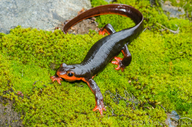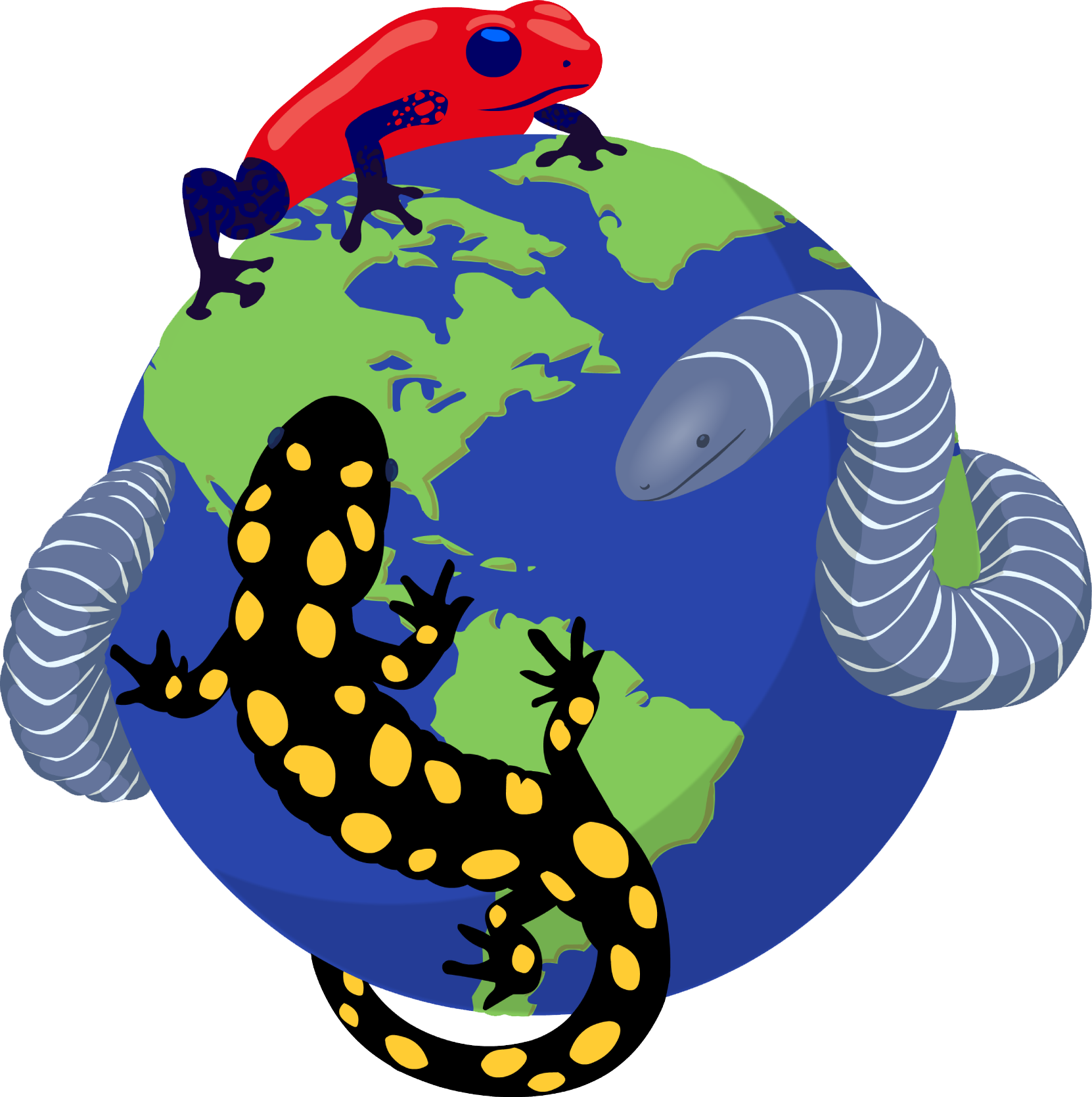|
Taricha rivularis (Twitty, 1935)
Red-bellied Newt Subgenus: Twittya | family: Salamandridae subfamily: Pleurodelinae genus: Taricha |
 © 2013 John P. Clare (1 of 61) |
|
|
|
Description Taricha rivularis may be distinguished from close relatives (T. granulosa and T. torosa) by relatively prominent eyes, brown iris, and bright red ventral coloration with a dark bar across its vent (Stebbins 1951; Petranka 1998). Distribution and Habitat Country distribution from AmphibiaWeb's database: United States U.S. state distribution from AmphibiaWeb's database: California
In 2014, several individuals were discovered in Santa Clara County, significantly south (ca. 130 km) from its previously known range (Reilly et al. 2014). These adults were seen with egg masses so recruitment is likely. Reilly et al (2014) tried to determine the origin of this disjunct population by comparing a few molecular markers with populations from the north of San Francisco Bay. However due to the extremely low genetic diversity across its range it was inconclusive whether the population in Santa Clara County represents a previously unknown but natural range extension or an introduced population. Life History, Abundance, Activity, and Special Behaviors Diet is likely composed of terrestrial and aquatic invertebrates although this has been poorly studied (Petranka 1998). When attacked, T. rivularis assumes the characteristic "unken reflex" of all species of Taricha: the tail and head are raised to expose the bright red belly as a warning to predators (Brodie 1977). All Taricha produce the neurotoxin known as tetrodotoxin, which is toxic to their predators and humans (Brodie et al. 1974; Petranka 1998). Trends and Threats Based on low genetic diversity, limited geographic range and potential habitat, and high potential for habitat disturbance, Reilly et al (2014) recommends conservation protection for this species. Possible reasons for amphibian decline Loss of genetic diversity from small population phenomena Comments See another account at californiaherps.com. This species was featured as News of the Week on 2 August 2021: Most amphibians secrete distasteful or toxic substances from their skin. Several groups wield toxins that can be lethal to other animals, or even to themselves. Animals can evolve resistance to toxins through mutations in proteins that prevent toxins from binding. Although these mutations can provide resistance, they often occur in important regions of a protein, such as those critical to nervous system functions. Thus, a problem arises: how can animals avoid the negative effects of mutations that also provide resistance? A pair of recent studies, one on the toxic salamanders Taricha (Gendreau et al. 2021) and another on frogs of the genus Leptodactylus (Mohammadi et al. 2021), which consume toxic toads, suggest that gene duplication is the key; one gene copy can help animals develop toxin resistance while the other copy maintains a functional nervous system. Both studies also show evidence for a fascinating molecular process known as gene conversion, wherein duplicate copies of one gene retain more similar-than-expected DNA sequences. During homologous recombination, two copies of a genome line up and exchange pieces of DNA; however, when two copies of a gene are near each other in the genome, the wrong genes can line up and exchange genetic material, maintaining genetic similarity between duplicate copies of a gene. In newts, gene conversion appears to have copied resistance-conferring mutations from one gene domain to another. In Leptodactylus frogs, strong natural selection countered the force of gene conversion, resulting in one toxin-resistant gene and one toxin-sensitive gene. How newts and frogs regulate the use of these different gene copies remains unknown and will be an exciting future research topic. (RT)
References
Brodie, E. D., Jr. (1977). "Salamander antipredator postures." Copeia, 1977, 523-535. Brodie, E. D., Jr., Hensel, J. L., and Johnson, J. A. (1974). ''Toxicity of the urodele amphibians Taricha, Notophthalmus, Cynops, and Paramesotriton (Family Salamandridae).'' Copeia, 1974(2), 506-511. Petranka, J. W. (1998). Salamanders of the United States and Canada. Smithsonian Institution Press, Washington D.C. and London. Reilly, S.B., Portik, D.M., Koo, M.S., and Wake, D.B. (2014). ''Discovery of a New, Disjunct Population of a Narrowly Distributed Salamander (Taricha rivularis) in California Presents Conservation Challenges.'' Journal of Herpetology, 48(3), 371-379 . Stebbins, R. C. (1972). Amphibians and Reptiles of California. University of California Press, Berkeley, Los Angeles, London. Stebbins, R. C. (1985). A Field Guide to Western Reptiles and Amphibians. Houghton Mifflin, Boston. Stebbins, R.C. (1951). Amphibians of Western North America. University of California Press, Berkeley. Twitty, V. C. (1964). ''Taricha rivularis (Twitty). Red-bellied Newt.'' Catalogue of American Amphibians and Reptiles. American Society of Ichthyologists and Herpetologists, 9.1-9.2. Originally submitted by: Rachel L. Mueller, Meredith J. Mahoney, and Michelle Koo (first posted 1999-02-22) Distribution by: Michelle S. Koo (updated 2021-08-02)
Life history by: Michelle S. Koo (updated 2021-08-02)
Trends and threats by: Michelle S. Koo (updated 2021-08-02)
Comments by: Michelle S. Koo (updated 2021-08-02)
Edited by: Meredith J. Mahoney, Kevin Gin, Michelle S. Koo (2021-08-10) Species Account Citation: AmphibiaWeb 2021 Taricha rivularis: Red-bellied Newt <https://amphibiaweb.org/species/4289> University of California, Berkeley, CA, USA. Accessed Jun 4, 2025.
Feedback or comments about this page.
Citation: AmphibiaWeb. 2025. <https://amphibiaweb.org> University of California, Berkeley, CA, USA. Accessed 4 Jun 2025. AmphibiaWeb's policy on data use. |




 Raffaëlli Account
Raffaëlli Account Map of Life
Map of Life